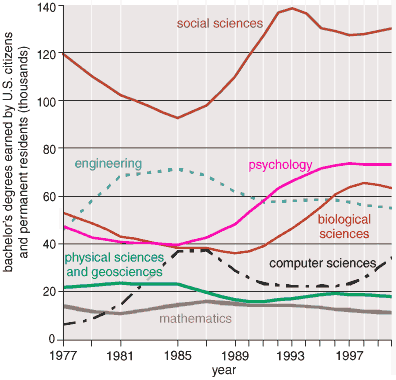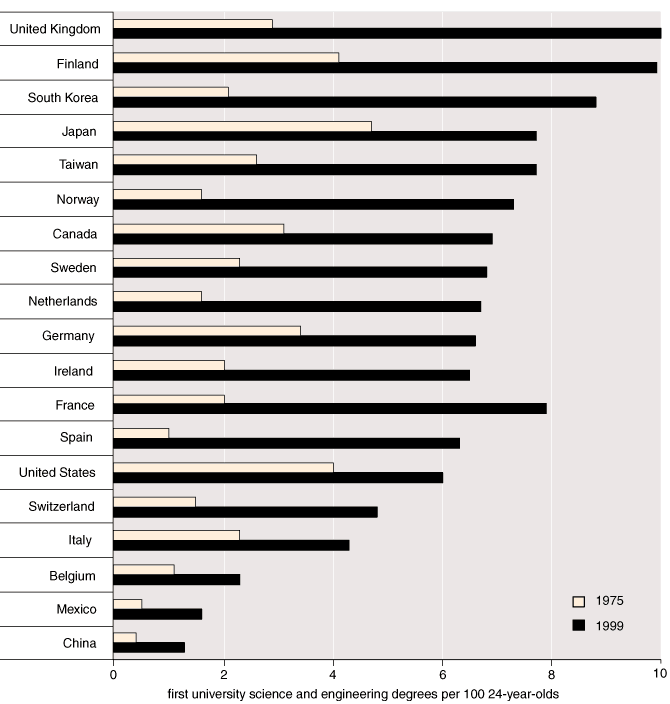The Pipeline: Still Leaking
By Fiona Margaret Goodchild
What should we make of the ongoing decline in the U.S. science and engineering workforce?
What should we make of the ongoing decline in the U.S. science and engineering workforce?

DOI: 10.1511/2004.46.112
Late in 2003 the National Science Board released a new report, Realizing America's Potential, calling for national attention to the future of the country's science and engineering workforce. The report advocates national workforce policies to address "the potential peril to U.S. strength in science and engineering" and argues that the nation's scientific enterprise is threatened by declining participation by native-born students in science, technology, engineering and mathematics. There are not going to be enough skilled practitioners, research scientists and educators, warns the NSB, to fill the growing number of occupations in science and engineering.

The report is timely, since changes in immigration law are already affecting the supply of qualified personnel who can work in the United States. Historically the U.S. has benefited from the contributions of scientists, engineers and graduate students from other countries. This solution to national needs looks less and less promising as other countries develop their research and development enterprises. The NSB includes science teachers in the workforce, highlighting the need to recruit more scientifically and mathematically trained graduates into education.
As I read through the report's introduction, I experienced twinges of déjà vu. This is where I came in. I started working in science education in the U.S. in 1990, the year that Richard Atkinson chose to talk about the Supply and Demand for Scientists and Engineers in his presidential address to the American Association for the Advancement of Science meeting in New Orleans. I saw those ubiquitous charts depicting the pipeline of potential science and engineering students that started at 4 million students and dwindled to 9,700 (0.24 percent) who were expected to achieve a Ph.D. in science or engineering. That rate of completion was judged to result in a serious shortfall in workforce numbers. The National Science Foundation was setting up a Division of Education and Human Resources and launching a new effort to integrate research science and education.
I was part of that initiative. I had taken a position as education coordinator at one of the NSF Science and Technology Centers that was in the vanguard of what is often described as "outreach." As I understood it, one of our important goals was to improve opportunities for learning and teaching science, supported by collaboration between research scientists—a term I use in the broader sense, to include engineers—and educators. As a former teacher who had just completed graduate research in cognitive psychology, I was intrigued by the challenge to promote more science education. I value the analytical and quantitative thinking that is a major facet of coursework in science, engineering and mathematics. Students usually get the chance to acquire this knowledge only inside a formal degree structure. Why do so many miss this opportunity? Was it possible to make the subject areas more attractive to a broader range of students? Could we make this national problem a scientific community problem?
I had spent over 10 years at a research university where I talked daily with students who wanted to improve their performance in math and science courses. Many struggled with math and then gave up on science or engineering. Others described introductory courses as a series of hoops and hurdles that only one in three students was expected to survive. At home I had listened to our teenage daughters express serious doubts about whether it was worth making the extra effort that science courses were famous (or notorious) for. I believed that I was fairly well versed about why many students do not choose science careers.
I began to work with research scientists who adopted new roles in a range of partnerships with science teachers and K–12 schools. One important goal was to connect with teachers so that they could develop enough familiarity and understanding to become "representatives of science in their classrooms," a theme highlighted in the emerging national standards for science teachers. Faculty also opened their lab groups to high school and community college interns. The design of the internship program highlighted communication, teamwork and mentoring to introduce younger students to some of the more intriguing ideas in current science and to encourage them to consider careers in science, engineering or mathematics. Once they got a closer look at how scientists work, we thought, they might form more realistic impressions that would contradict traditional images of science as isolated and antisocial. The policies of funding agencies such as NSF encourage the involvement of scientists in such ventures. NSF's requirement that investigators make a broader impact has created new interest in the way that scientists can influence the next generation.
As we recruited volunteer undergraduates, we found that they had a strong interest in projects that appeared to enhance their professional skills and broaden their understanding of how they could apply their science and math training. Their new role in creating or demonstrating teaching resources seemed to help them understand the relevance of their academic work and to make connections with the community. It became clear that many undergrads in science and engineering courses appreciate the chance to study a complementary topic, such as business or art or education, and to think more about how their scientific training could he applied in other fields. It wasn't just K–12 science that needed attention.
When we tracked the progress of former interns, we ran into questions about the nature of the next step after high school or community college—undergraduate science and engineering. We heard reports of competitive and intimidating introductory courses, and of textbook-oriented teaching that was disconnected from the problems that they had worked on in research labs. High school teachers were disappointed to find that their most promising science students reported that they were switching out of undergraduate science. Had we created unrealistic expectations? A more plausible explanation seemed to be that these young students had encountered the traditional mining-and-sorting approach that underpins many courses that select for only the "best and the brightest" and therefore require that students be graded on a curve. Our projects were based on the assumption that it would be useful for all students to understand the value of scientific thinking. Their college courses made it clear that only certain students would be selected as majors or prospective graduate students.

Data from the National Science Foundation's Science and Engineering Indicators 2002. China's data are for 1985 and 1999
The new NSB report confirms the bottleneck at the undergraduate-degree level. Between 1985 and 2000 the number of baccalaureate degrees in the STEM (science, technology, engineering and mathematics) fields, excluding biology, fell by 18.6 percent. Once young students arrive in community college and undergraduate courses, serious attrition occurs. As this report documents, fewer than half of those students intending to major in science and engineering fields complete that degree within five years. Members of underrepresented minorities drop out at a higher rate than other groups. The trend for participation by domestic students is downward. The U.S. has slipped from third to thirteenth place in terms of undergraduate completion of STEM degrees since 1975.
Does the report reveal what the disincentives and obstacles may be? The section on college programs argues for the necessary equipment and resources to teach laboratory courses and calls for "modification of the educational environment, particularly better teaching and advising" to improve the nature of introductory courses and the focus on the individual student. However, it does not explore what modifications are required and what specific problems may be causing students to lose interest in studying science.
Such questions, which require analysis of current teaching practices, are of vital importance to the future of the scientific workforce of the 21st century. Many features of undergraduate programs now seem disconnected from the interests and motivation of the students who are graduating from high school. Many of these students are looking for relevance and the chance to explore how their major might prepare them for the workforce. Those from nontraditional backgrounds need more flexibility in sequencing and options, and more chances to connect with practicing scientists. They need more realism about the economic factors inherent in pursuing a career in science and engineering. Many female students are looking to identify careers that integrate a social contribution—beyond the stereotypical role of teacher. It seems a matter of urgency to resolve some of the basic tension between the rigor that science courses demand and the attention to instruction and mentoring that students need and appreciate.
This challenge does not seem impossible to address. Undergraduate science is the part of science education that can be controlled by academic scientists. Some of them have already made recommendations on new pedagogy and instructional strategies. What seems even more pertinent is the need to focus on how to design comprehensive academic courses, alongside access to social networks within individual departments and career contacts that help students to envisage their future prospects. For example, the American Institute of Physics recently published a report on Strategic Programs for Undergraduate Physics that stresses the importance of collaboration between academic faculty to improve student retention in undergraduate physics programs.
Reading the NSB report from a grass-roots perspective, I would have liked to see much more focus on the incentives and rewards that are needed to nurture those students who do register in undergraduate science and engineering courses. These are the human resources that are most likely to guarantee scientific excellence.
Click "American Scientist" to access home page
American Scientist Comments and Discussion
To discuss our articles or comment on them, please share them and tag American Scientist on social media platforms. Here are links to our profiles on Twitter, Facebook, and LinkedIn.
If we re-share your post, we will moderate comments/discussion following our comments policy.